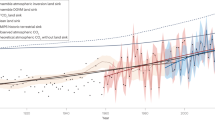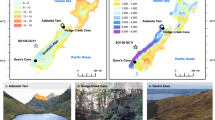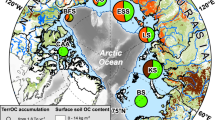Abstract
Tranvik and Jansson question our proposed link between temperature and DOC export, on the basis of spatial patterns of DOC concentration, confounding effects of hydrology, and apparently conflicting observations from other regions.
Similar content being viewed by others
Freeman et al. reply
In response, it is first necessary to distinguish factors that control spatial variation between sites from those that determine temporal variation at an individual site. For example, a catchment wetland area is unlikely to change on a decadal timescale. Tranvik and Jansson also comment that DOC is higher in cooler regions, where low decomposition rates allow peat to accumulate. In fact, this spatial relationship between temperature and decomposition is fully consistent with our proposed mechanism for peatlands in the United Kingdom, because rising temperature at an individual site will increase peat decomposition, leading to greater DOC export.
We agree that hydrological changes can significantly affect DOC export. It is useful here to consider DOC export as a two-stage process: DOC is first produced in the soil and is then transported from the soil to the drainage network. The transport stage is controlled by discharge, so hydrology influences short-term fluctuations in riverine DOC export. However, long-term changes in discharge, unless accompanied by changes in DOC production, cannot generate a sustained trend in DOC flux. Flowpath changes may affect DOC supply by altering the proportion that is adsorbed onto mineral horizons, but such changes are probably unimportant in peatlands.
The primary hydrological factor that influences peatland DOC production, and hence long-term trends, may therefore be soil moisture, because greater soil aeration under dryer conditions will increase decomposition (for example, through greater enzymatic activity1). This could enhance DOC production over and above the temperature-induced increases that we have observed experimentally. Soil moisture is influenced by both rainfall and temperature and, although temperature has increased in the United Kingdom in recent decades, regional rainfall patterns have been more heterogeneous, with few trends in annual means. In some areas, however, increases in winter/summer rainfall ratios2 may have contributed to DOC increases by reducing soil moisture in summer, with increased washout in winter.
Tranvik and Jansson note that warmer and dryer conditions in northwestern Ontario led to reduced DOC concentrations, partly through enhanced in-lake removal as a result of longer residence times3. Soils in this region are thin, and recently decomposed plant material provides a substantial and relatively labile DOC source4. DOC from blanket peats in the United Kingdom is older and more recalcitrant, and input–output data for British upland lakes, which generally have lower residence times, suggest that in-lake removal is minimal5. Similar DOC trends at our stream sites also argue against in-lake factors. Furthermore, DOC from peat uplands persists into the lower reaches of UK rivers6, which is consistent with observations that the riverine DOC that enters the oceans largely comprises old, recalcitrant compounds7.
We agree that terrestrial organic carbon exports are important for both freshwater and oceanic environments, and that climate change may significantly affect these exports. We contend that increasing temperatures, by raising decomposition rates, will increase peatland DOC export, but recognize that other factors, such as hydrological changes, may also be important. Given the ongoing debate about the direction and magnitude of rainfall projections made by the International Panel on Climate Change, future climatic impacts on DOC export remain uncertain.
References
Freeman, C., Ostle, N. & Kang, H. Nature 409, 149 (2001).
Burt, T. P., Adamson, J. K. & Lane, A. M. J. Hydrol. Sci. J. 43, 775–787 (1998).
Schindler, D. W. et al. Biogeochemistry 36, 9–28 (1997).
Schiff, S. L. et al. Biogeochemistry 36, 43–65 (1997).
Curtis, C. J., Harriman, R., Allott, T. E. H. & Kernan, M. Environ. Change Res. Centre Res. Rep. 50 (Univ. College London, 1998).
Worrall, F., Burt, T. P. & Shedden, R. Biogeochemistry (submitted).
Raymond, P. A. & Bauer, J. E. Nature 409, 497–499 (2001).
Author information
Authors and Affiliations
Rights and permissions
About this article
Cite this article
Evans, C., Freeman, C., Monteith, D. et al. Terrestrial export of organic carbon. Nature 415, 862 (2002). https://doi.org/10.1038/415862a
Issue Date:
DOI: https://doi.org/10.1038/415862a
This article is cited by
-
Dissolved organic carbon leaching from montane grasslands under contrasting climate, soil and management conditions
Biogeochemistry (2019)
-
Ecosystem respiration in a heterogeneous temperate peatland and its sensitivity to peat temperature and water table depth
Plant and Soil (2013)
-
Processes controlling DOC in pore water during simulated drought cycles in six different UK peats
Biogeochemistry (2012)
-
Acidification at Plastic Lake, Ontario: Has 20 Years Made a Difference?
Water, Air, & Soil Pollution: Focus (2007)
-
Modelling the effects of climate change on an acidic upland stream
Biogeochemistry (2005)
Comments
By submitting a comment you agree to abide by our Terms and Community Guidelines. If you find something abusive or that does not comply with our terms or guidelines please flag it as inappropriate.



